Rigol DS1074Z-S Plus, DS1054Z, MSO1074Z, DS1104Z-S Plus, DS1104Z Plus User Manual
...RIGOL
User’s Guide
MSO1000Z/DS1000Z Series
Digital Oscilloscope
Dec. 2015
RIGOL TECHNOLOGIES, INC.

RIGOL
Guaranty and Declaration
Copyright
© 2014 RIGOL TECHNOLOGIES, INC. All Rights Reserved.
Trademark Information
RIGOL is a registered trademark of RIGOL TECHNOLOGIES, INC.
Publication Number
UGA19110-1110
Software Version
00.04.03.SP2
Software upgrade might change or add product features. Please acquire the latest version of the manual from RIGOL website or contact RIGOL to upgrade the software.
Notices
RIGOL products are covered by P.R.C. and foreign patents, issued and pending.
RIGOL reserves the right to modify or change parts of or all the specifications and pricing policies at the company’s sole decision.
Information in this publication replaces all previously released materials.
Information in this publication is subject to change without notice.
RIGOL shall not be liable for either incidental or consequential losses in connection with the furnishing, use, or performance of this manual, as well as any information contained.
Any part of this document is forbidden to be copied, photocopied, or rearranged without prior written approval of RIGOL.
Product Certification
RIGOL guarantees that this product conforms to the national and industrial standards in China as well as the ISO9001:2008 standard and the ISO14001:2004 standard. Other international standard conformance certifications are in progress.
Contact Us
If you have any problem or requirement when using our products or this manual, please contact RIGOL.
E-mail: service@rigol.com Website: www.rigol.com
MSO1000Z/DS1000Z User’s Guide |
I |

RIGOL
Safety Requirement
General Safety Summary
Please review the following safety precautions carefully before putting the instrument into operation so as to avoid any personal injury or damage to the instrument and any product connected to it. To prevent potential hazards, please follow the instructions specified in this manual to use the instrument properly.
Use Proper Power Cord.
Only the exclusive power cord designed for the instrument and authorized for use within the local country could be used.
Ground the Instrument.
The instrument is grounded through the Protective Earth lead of the power cord. To avoid electric shock, connect the earth terminal of the power cord to the Protective Earth terminal before connecting any input or output terminals.
Connect the Probe Correctly.
If a probe is used, do not connect the ground lead to high voltage since it has isobaric electric potential as the ground.
Observe All Terminal Ratings.
To avoid fire or shock hazard, observe all ratings and markers on the instrument and check your manual for more information about ratings before connecting the instrument.
Use Proper Overvoltage Protection.
Ensure that no overvoltage (such as that caused by a bolt of lightning) can reach the product. Otherwise, the operator might be exposed to the danger of an electric shock.
Do Not Operate Without Covers.
Do not operate the instrument with covers or panels removed.
Do Not Insert Anything Into the Air Outlet.
Do not insert anything into the air outlet to avoid damage to the instrument.
Use Proper Fuse.
Please use the specified fuses.
Avoid Circuit or Wire Exposure.
Do not touch exposed junctions and components when the unit is powered on.
II |
MSO1000Z/DS1000Z User’s Guide |

RIGOL
Do Not Operate With Suspected Failures.
If you suspect that any damage may occur to the instrument, have it inspected by RIGOL authorized personnel before further operations. Any maintenance, adjustment or replacement especially to circuits or accessories must be performed by RIGOL authorized personnel.
Provide Adequate Ventilation.
Inadequate ventilation may cause an increase of temperature in the instrument, which would cause damage to the instrument. So please keep the instrument well ventilated and inspect the air outlet and the fan regularly.
Do Not Operate in Wet Conditions.
To avoid short circuit inside the instrument or electric shock, never operate the instrument in a humid environment.
Do Not Operate in an Explosive Atmosphere.
To avoid personal injuries or damage to the instrument, never operate the instrument in an explosive atmosphere.
Keep Instrument Surfaces Clean and Dry.
To avoid dust or moisture from affecting the performance of the instrument, keep the surfaces of the instrument clean and dry.
Prevent Electrostatic Impact.
Operate the instrument in an electrostatic discharge protective environment to avoid damage induced by static discharges. Always ground both the internal and external conductors of cables to release static before making connections.
Use the Battery Properly.
Do not expose the battery (if available) to high temperature or fire.
Keep it out of the reach of children. Improper change of a battery (lithium battery) may cause an explosion. Use the RIGOL specified battery only.
Handle with Caution.
Please handle with care during transportation to avoid damage to keys, knobs, interfaces, and other parts on the panels.
MSO1000Z/DS1000Z User’s Guide |
III |
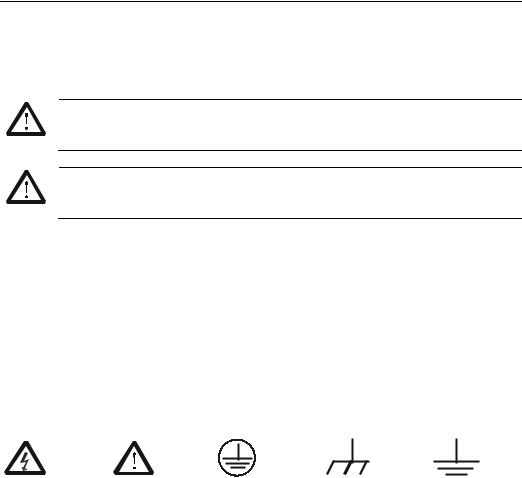
RIGOL
Safety Notices and Symbols
Safety Notices in this Manual:
WARNING
Indicates a potentially hazardous situation or practice which, if not avoided, will result in serious injury or death.
CAUTION
Indicates a potentially hazardous situation or practice which, if not avoided, could result in damage to the product or loss of important data.
Safety Terms on the Product:
DANGER
WARNING
CAUTION
Safety Symbols on the Product:
Hazardous |
Safety |
Protective |
Chassis |
Test |
Voltage |
Warning |
Earth |
Ground |
Ground |
|
|
Terminal |
|
|
IV |
MSO1000Z/DS1000Z User’s Guide |

RIGOL
Allgemeine Sicherheits Informationen
Überprüfen Sie diefolgenden Sicherheitshinweise sorgfältigumPersonenschädenoderSchäden am Gerätundan damit verbundenen weiteren Gerätenzu vermeiden. Zur Vermeidung vonGefahren, nutzen Sie bitte das Gerät nur so, wiein diesem Handbuchangegeben.
Um Feuer oder Verletzungen zu vermeiden, verwenden Sie ein ordnungsgemäßes Netzkabel.
Verwenden Sie für dieses Gerät nur das für ihr Land zugelassene und genehmigte Netzkabel.
Erden des Gerätes.
Das Gerät ist durch den Schutzleiter im Netzkabel geerdet. Um Gefahren durch elektrischen Schlag zu vermeiden, ist es unerlässlich, die Erdung durchzuführen. Erst dann dürfen weitere Einoder Ausgänge verbunden werden.
Anschluss einesTastkopfes.
Die Erdungsklemmen der Sonden sindauf dem gleichen Spannungspegel des Instruments geerdet. SchließenSie die Erdungsklemmen an keine hohe Spannung an.
Beachten Sie alle Anschlüsse.
Zur Vermeidung von Feuer oder Stromschlag, beachten Sie alle Bemerkungen und Markierungen auf dem Instrument. Befolgen Sie die Bedienungsanleitung für weitere Informationen, bevor Sie weitere Anschlüsse an das Instrument legen.
Verwenden Sie einen geeigneten Überspannungsschutz.
Stellen Sie sicher, daß keinerlei Überspannung (wie z.B. durch Gewitter verursacht) das Gerät erreichen kann. Andernfallsbestehtfür den Anwender die GefahreinesStromschlages.
Nicht ohne Abdeckung einschalten.
Betreiben Sie das Gerät nicht mit entfernten Gehäuse-Abdeckungen.
Betreiben Sie das Gerät nicht geöffnet.
Der Betrieb mit offenen oder entfernten Gehäuseteilen ist nicht zulässig. Nichts in entsprechende Öffnungen stecken (Lüfter z.B.)
Passende Sicherung verwenden.
Setzen Sie nur die spezifikationsgemäßen Sicherungen ein.
Vermeiden Sie ungeschützte Verbindungen.
Berühren Sie keine unisolierten Verbindungen oder Baugruppen, während das Gerät in Betrieb ist.
MSO1000Z/DS1000Z User’s Guide |
V |

RIGOL
Betreiben Sie das Gerät nicht im Fehlerfall.
Wenn Sie am Gerät einen Defekt vermuten, sorgen Sie dafür, bevor Sie das Gerät wieder betreiben, dass eine Untersuchung durch RIGOL autorisiertem Personal durchgeführt wird. Jedwede Wartung, Einstellarbeiten oder Austausch von Teilen am Gerät, sowie am Zubehör dürfen nur von RIGOL autorisiertem Personal durchgeführt werden.
Belüftung sicherstellen.
Unzureichende Belüftung kann zu Temperaturanstiegen und somit zu thermischen Schäden am Gerät führen. Stellen Sie deswegen die Belüftung sicher und kontrollieren regelmäßig Lüfter und Belüftungsöffnungen.
Nicht in feuchter Umgebung betreiben.
Zur Vermeidung von Kurzschluß im Geräteinneren und Stromschlag betreiben Sie das Gerät bitte niemals in feuchter Umgebung.
Nicht in explosiver Atmosphäre betreiben.
Zur Vermeidung von Personenund Sachschäden ist es unumgänglich, das Gerät ausschließlich fernab jedweder explosiven Atmosphäre zu betreiben.
Geräteoberflächen sauber und trocken halten.
Um den Einfluß von Staub und Feuchtigkeit aus der Luft auszuschließen, halten Sie bitte die Geräteoberflächen sauber und trocken.
Schutz gegen elektrostatische Entladung (ESD).
Sorgen Sie für eine elektrostatisch geschützte Umgebung, um somit Schäden und Funktionsstörungen durch ESD zu vermeiden. Erden Sie vor dem Anschluß immer Innenund Außenleiter der Verbindungsleitung, um statische Aufladung zu entladen.
Die richtige Verwendung desAkku.
Wenneine Batterieverwendet wird, vermeiden Sie hohe Temperaturen bzw. Feuer ausgesetzt werden. Bewahren Sie es außerhalbder Reichweitevon Kindern auf. UnsachgemäßeÄnderung derBatterie (Anmerkung: Lithium-Batterie) kann zu einer Explosion führen. VerwendenSie nur von RIGOL angegebenenAkkus.
Sicherer Transport.
Transportieren Sie das Gerät sorgfältig (Verpackung!), um Schäden an Bedienelementen, Anschlüssen und anderen Teilen zu vermeiden.
VI |
MSO1000Z/DS1000Z User’s Guide |

RIGOL
Sicherheits Begriffe und Symbole
Begriffe in diesem Guide:
WARNING
Die Kennzeichnung WARNING beschreibt Gefahrenquellen die leibliche Schäden oder den Tod von Personen zur Folge haben können.
CAUTION
Die Kennzeichnung Caution (Vorsicht) beschreibt Gefahrenquellen die Schäden am Gerät hervorrufen können.
Begriffe auf dem Produkt:
DANGER weist auf eine Verletzung oder Gefährdung hin, die sofort geschehen kann.
WARNING weist auf eine Verletzung oder Gefährdung hin, die möglicherweise nicht sofort geschehen.
CAUTION weist auf eine Verletzung oder Gefährdung hin und bedeutet, dass eine mögliche Beschädigung des Instruments oder anderer Gegenstände auftreten kann.
Symbole auf dem Produkt:
Gefährliche |
Sicherheits- |
Schutz-erde |
Gehäusemasse |
Erde |
|
Spannung |
Hinweis |
||||
|
|
|
MSO1000Z/DS1000Z User’s Guide |
VII |

RIGOL
Measurement Category
Measurement Category
MSO1000Z/DS1000Z series digital oscilloscopes can make measurements in Measurement Category I.
WARNING
This oscilloscope can only be used for measurements within its specified measurement categories.
Measurement Category Definitions
Measurement category I is for measurements performed on circuits not directly connected to MAINS. Examples are measurements on circuits not derived from MAINS, and specially protected (internal) MAINS derived circuits. In the latter case, transient stresses are variable. For that reason, the transient withstand capability of the equipment is made known to the user.
Measurement category II is for measurements performed on circuits directly connected to low voltage installations. Examples are measurements on household appliances, portable tools and similar equipment.
Measurement category III is for measurements performed in building installations. Examples are measurements on distribution boards, circuit-breakers, wiring (including cables, bus-bars, junction boxes, switches and socket-outlets) in fixed installations, equipment for industrial use and some other equipment. For example, stationary motors with permanent connection to a fixed installation.
Measurement category IV is for measurements performed at the source of a low-voltage installation. Examples are electricity meters and measurements on primary overcurrent protection devices and ripple control units.
VIII |
MSO1000Z/DS1000Z User’s Guide |

RIGOL
Ventilation Requirement
This oscilloscope uses fan to force cooling. Please make sure that the air intake and exhaust areas are free from obstructions and have free air. When using the oscilloscope in a bench-top or rack setting, provide at least 10 cm clearance beside, above and behind the instrument for adequate ventilation.
WARNING
Inadequate ventilation may cause a temperature increase which can damage the instrument. So please keep the instrument well ventilated during operation and inspect the intake and fan regularly.
MSO1000Z/DS1000Z User’s Guide |
IX |
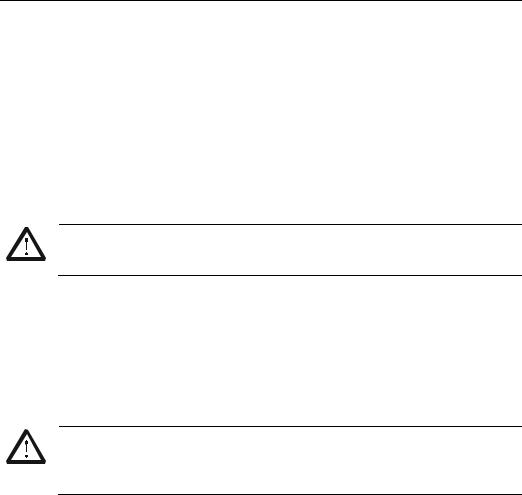
RIGOL
Working Environment
Temperature
Operating: 0 to +50
Non-operating: -40 to +70
Humidity
0 to +30 : ≤95% relative humidity +30 to +40 : ≤75% relative humidity +40 to +50 : ≤45% relative humidity
WARNING
To avoid short circuits inside the instrument or electric shocks, please do not operate in humid environment.
Altitude
Operating: below 3 km
Non-operating: below 15 km
Installation (Overvoltage) Category
This product is powered by mains conforming to installation (overvoltage) category II.
WARNING
Make sure that no overvoltage (such as that produced by a thunderstorm) can reach the product, or else the operator might be exposed to the danger of electric shock.
Installation (Overvoltage) Category Definitions
Installation (overvoltage) category I refers to signal level which is applicable to equipment measurement terminals connected to the source circuit. In these terminals, precautions are done to limit the transient voltage to the corresponding low level.
Installation (overvoltage) category II refers to the local power distribution level which is applicable to equipment connected to the AC line (AC power).
Pollution Degree
Degree 2
Pollution Degree Definitions
Pollution degree 1: No pollution or only dry, non-conductive pollution occurs. The pollution has no influence. For example, a clean room or air-conditioned office environment.
X |
MSO1000Z/DS1000Z User’s Guide |

RIGOL
Pollution degree 2: Normally only dry, non-conductive pollution occurs. Occasionally a temporary conductivity caused by condensation may occur. For example, general indoor environment.
Pollution degree 3: Conductive pollution occurs, or dry, non-conductive pollution occurs which becomes conductive due to condensation which is expected. For example, sheltered outdoor environment.
Pollution degree 4: Pollution that generates persistent conductivity through conductive dust, rain, or snow. For example, outdoor locations.
Safety Class
Class 1 – Grounded Product
MSO1000Z/DS1000Z User’s Guide |
XI |

RIGOL
Care and Cleaning
Care
Do not store or leave the instrument where it may be exposed to direct sunlight for long periods of time.
Cleaning
Clean the instrument regularly according to its operating conditions.
1.Disconnect the instrument from all power sources.
2.Clean the external surfaces of the instrument with a soft cloth dampened with mild detergent or water. When cleaning the LCD, take care to avoid scarifying it.
CAUTION
To avoid damage to the instrument, do not expose it to caustic liquids.
WARNING
To avoid short-circuit resulting from moisture or personal injuries, ensure that the instrument is completely dry before connecting it to the power supply.
Environmental Considerations
The following symbol indicates that this product complies with the WEEE Directive 2002/96/EC.
Product End-of-Life Handling
The equipment may contain substances that could be harmful to the environment or human health. To avoid the release of such substances into the environment and avoid harm to human health, we recommend you to recycle this product appropriately to ensure that most materials are reused or recycled properly. Please contact your local authorities for disposal or recycling information.
XII |
MSO1000Z/DS1000Z User’s Guide |
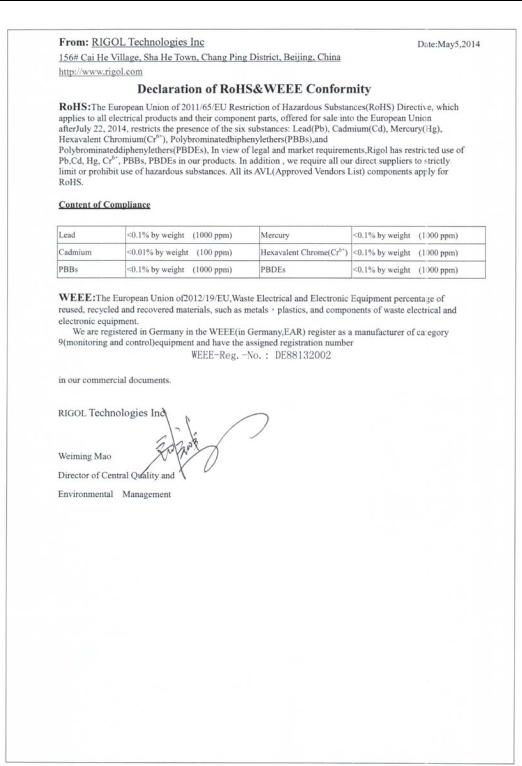
RIGOL
MSO1000Z/DS1000Z User’s Guide |
XIII |

RIGOL
MSO1000Z/DS1000Z Series Overview
MSO1000Z/DS1000Z series is a multifunctional and high-performance digital oscilloscope designed on the basis of the UltraVision technique developed by RIGOL. Featuring extremely high memory depth, wide dynamic range, clear display, excellent waveform capture rate and comprehensive triggering functions, it is a useful commissioning instrument for various fields such as communication, aerospace, defense, embedded systems, computers, research and education. Wherein, the mixed signal digital oscilloscope aimed at the embedded design and test fields allows users to measure analog and digital signals at the same time. MSO1000Z/DS1000Z is the one with the most comprehensive functions and the most outstanding specifications among the 100 MHz bandwidth digital oscilloscopes.
Main features:
1 GSa/s real-time sample rate of the analog channels; up to 24 Mpts memory depth (optional) and 12 Mpts standard memory depth
1 GSa/s real-time sample rate of the digital channels
100 MHz, 70 MHz and 50 MHz analog channel bandwidth
4 analog channels, 16 digital channels (for MSO1000Z and MSO upgradable for DS1000Z Plus)
Dual-channel 25 MHz signal source (applicable to digital oscilloscopes with source channels)
30 000 wfms/s (dots display) waveform capture rate
Real-time hardware waveform recording and playback functions; up to 60 000 frames of waveform can be recorded
MSO field upgradable with MSO1000Z upgrade package (MSO upgrade option, only for DS1000Z Plus)
Intensity graded color display
Low base noise, 1 mV/div to 10 V/div ultra-wide vertical dynamic range
7.0 inch WVGA (800*480) TFT LCD, with ultra-wide screen, vivid picture, low power consumption and long service life
Adjustable waveform brightness
Auto setting of waveform display (AUTO)
Up to 15 kinds of trigger functions, including various protocol triggers
Standard parallel decoding, supports multiple serial decoding options
Auto measurement of 37 waveform parameters (with statistics)
Fine delayed sweep function
Built-in FFT function
Multiple waveform math operation functions
Pass/fail test function
Standard interfaces: USB Device, USB Host, LAN and Aux
Conform to LXI CORE 2011 DEVICE class instrument standards; enable quick, economic and efficient creation and reconfiguration of test system
Supports remote command control
Built-in help to facilitate information acquisition
XIV |
MSO1000Z/DS1000Z User’s Guide |

RIGOL
Supports multiple languages and Chinese/English input
Novel and delicate industrial design and easy operation
MSO1000Z/DS1000Z User’s Guide |
XV |

RIGOL
Document Overview
Main Topics of this Manual:
Chapter 1 Quick Start
Introduce the preparations before using the oscilloscope and provide a basic introduction of the instrument.
Chapter 2 To Set the Vertical System
Introduce the vertical system functions of the oscilloscope.
Chapter 3 To Set the Horizontal System
Introduce the horizontal system functions of the oscilloscope.
Chapter 4 To Set the Sample System
Introduce the sample system functions of the oscilloscope.
Chapter 5 To Trigger the Oscilloscope
Introduce the trigger mode, trigger coupling, trigger holdoff, external trigger and various trigger types of the oscilloscope.
Chapter 6 MATH and Measurement
Introduce how to make math operation, auto measurement and cursor measurement.
Chapter 7 Digital Channel
Introduce how to use the digital channels of the mixed signal digital oscilloscope.
Chapter 8 Protocol Decoding
Introduce how to decode the input signal using those common protocols.
Chapter 9 Reference Waveform
Introduce how to compare the input waveform with the reference waveform.
Chapter 10 Pass/Fail Test
Introduce how to monitor the input signal using the Pass/Fail test.
Chapter 11 Waveform Record
Introduce how to analyze the input signal using waveform record.
Chapter 12 Display Control
Introduce how to control the display of the oscilloscope.
Chapter 13 Signal Source
Introduce how to use the built-in signal source.
XVI |
MSO1000Z/DS1000Z User’s Guide |
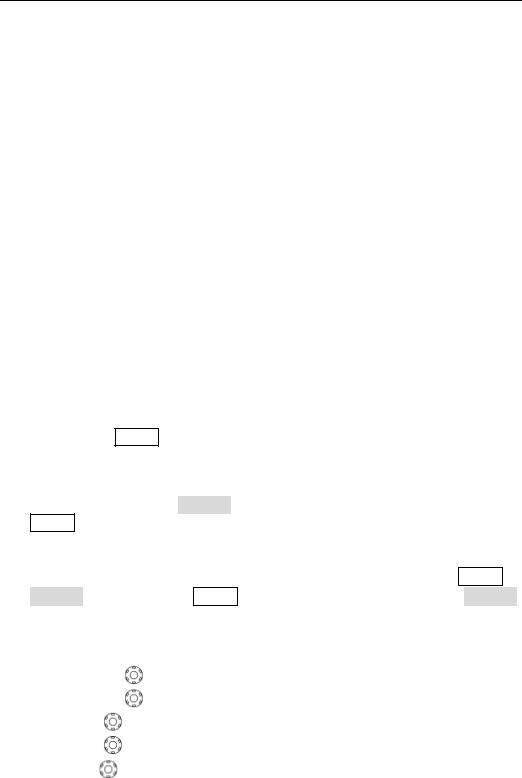
RIGOL
Chapter 14 Store and Recall
Introduce how to store and recall the measurement result and the setting of the oscilloscope.
Chapter 15 Accessibility Setting
Introduce how to set the remote interfaces and system-related functions.
Chapter 16 Remote Control
Introduce how to control the oscilloscope remotely.
Chapter 17 Troubleshooting
Introduce how to deal with the common failures of the oscilloscope.
Chapter 18 Specifications
Provide the specifications and general specifications of the oscilloscope.
Chapter 19 Appendix
Provide common information such as the options and accessories.
Format Conventions in this Manual:
1.Key
The front panel keys are denoted by the format of "Key Name (Bold) + Text Box". For example, Utility denotes the "Utility" key.
2.Menu
The menu items are denoted by the format of "Menu Word (Bold) + Character Shading". For example, System denotes the "System" menu item under
Utility.
3.Operation Step
The next step of operation is denoted by an arrow "". For example, Utility System denotes pressing Utility at the front panel and then pressing System.
4.Knob
Label |
|
|
|
|
|
|
Knob |
||
|
|
|
|
|
|
|
|
|
|
HORIZONTAL |
SCALE |
|
Horizontal Scale Knob |
||||||
|
|
|
|
|
|
|
|
||
HORIZONTAL |
POSITION |
Horizontal Position Knob |
|||||||
|
|
|
|
|
|
|
|||
VERTICAL |
|
SCALE |
|
Vertical Scale Knob |
|||||
|
|
|
|
|
|||||
VERTICAL |
|
POSITION |
|
Vertical Position Knob |
|||||
|
|
|
|||||||
TRIGGER |
LEVEL |
Trigger Level Knob |
|||||||
|
|
|
|
|
|
|
|
|
|
MSO1000Z/DS1000Z User’s Guide |
XVII |

RIGOL
Content Conventions in this Manual:
MSO1000Z/DS1000Z series includes the following models. Unless otherwise noted, this manual takes MSO1104Z-S for example to illustrate the functions and operation methods of MSO1000Z/DS1000Z series.
|
Analog |
|
Number of |
|
Number of Source |
|
Number of |
|
Model |
|
Analog |
|
|
Digital |
|
||
Bandwidth |
|
|
Channels |
|
|
|||
|
|
Channels |
|
|
Channels |
|
||
|
|
|
|
|
|
|
||
MSO1104Z-S |
100 MHz |
4 |
2 |
16 |
|
|||
|
|
|
|
|
|
|||
MSO1074Z-S |
70 MHz |
4 |
2 |
16 |
|
|||
|
|
|
|
|
|
|||
MSO1104Z |
100 MHz |
4 |
-- |
16 |
|
|||
|
|
|
|
|
|
|||
MSO1074Z |
70 MHz |
4 |
-- |
16 |
|
|||
|
|
|
|
|
|
|||
DS1104Z-S Plus |
100 MHz |
4 |
2 |
16[1] |
|
|||
DS1074Z-S Plus |
70 MHz |
4 |
2 |
16[1] |
|
|||
DS1104Z Plus |
100 MHz |
4 |
-- |
16[1] |
|
|||
DS1074Z Plus |
70 MHz |
4 |
-- |
16[1] |
|
|||
DS1054Z |
50 MHz |
4 |
-- |
-- |
|
|||
Note[1]: Need to be upgraded to MSO using the MSO upgrade option.
Manuals of this Product:
The manuals of this product include the quick guide, user’s guide, programming guide, data sheet and etc. The latest versions of the manuals can be downloaded from RIGOL official website (www.rigol.com).
XVIII |
MSO1000Z/DS1000Z User’s Guide |
Contents |
RIGOL |
Contents |
|
Guaranty and Declaration ......................................................................... |
I |
Safety Requirement ................................................................................ |
II |
General Safety Summary........................................................................... |
II |
Safety Notices and Symbols...................................................................... |
IV |
Allgemeine Sicherheits Informationen......................................................... |
V |
Sicherheits Begriffe und Symbole ............................................................. |
VII |
Measurement Category .......................................................................... |
VIII |
Ventilation Requirement........................................................................... |
IX |
Working Environment ............................................................................... |
X |
Care and Cleaning .................................................................................. |
XII |
Environmental Considerations.................................................................. |
XII |
MSO1000Z/DS1000Z Series Overview................................................. |
XIV |
Document Overview............................................................................. |
XVI |
Chapter 1 Quick Start ......................................................................... |
1-1 |
General Inspection ................................................................................ |
1-2 |
Appearance and Dimensions................................................................... |
1-3 |
To Prepare the Oscilloscope for Use......................................................... |
1-4 |
To Adjust the Supporting Legs.......................................................... |
1-4 |
To Connect to Power Supply............................................................. |
1-4 |
Power-on Inspection ....................................................................... |
1-5 |
To Connect the Probe...................................................................... |
1-5 |
Function Inspection......................................................................... |
1-7 |
Probe Compensation ....................................................................... |
1-8 |
Front Panel Overview............................................................................. |
1-9 |
Rear Panel Overview............................................................................. |
1-10 |
Front Panel Function Overview............................................................... |
1-12 |
VERTICAL ..................................................................................... |
1-12 |
Logic Analyzer ............................................................................... |
1-13 |
Signal Source ................................................................................ |
1-13 |
HORIZONTAL ................................................................................ |
1-14 |
TRIGGER ...................................................................................... |
1-15 |
CLEAR .......................................................................................... |
1-15 |
AUTO............................................................................................ |
1-15 |
RUN/STOP .................................................................................... |
1-16 |
SINGLE......................................................................................... |
1-16 |
Multifunction Knob ......................................................................... |
1-16 |
Function Menus ............................................................................. |
1-17 |
Print ............................................................................................. |
1-18 |
User Interface...................................................................................... |
1-19 |
Parameter Setting Method..................................................................... |
1-24 |
To Use the Security Lock ....................................................................... |
1-25 |
MSO1000Z/DS1000Z User’s Guide |
XIX |
RIGOL |
Contents |
To Use the Built-in Help System............................................................. |
1-26 |
Chapter 2 To Set the Vertical System................................................. |
2-1 |
To Enable the Analog Channel ................................................................. |
2-2 |
Channel Coupling................................................................................... |
2-2 |
Bandwidth Limit..................................................................................... |
2-3 |
Probe Ratio ........................................................................................... |
2-3 |
Waveform Invert.................................................................................... |
2-4 |
Vertical Scale......................................................................................... |
2-4 |
Amplitude Unit....................................................................................... |
2-5 |
Channel Label........................................................................................ |
2-5 |
Delay Calibration of the Analog Channel ................................................... |
2-7 |
Chapter 3 To Set the Horizontal System ............................................ |
3-1 |
Delayed Sweep ...................................................................................... |
3-2 |
Time Base Mode .................................................................................... |
3-3 |
YT Mode......................................................................................... |
3-3 |
XY Mode......................................................................................... |
3-3 |
Roll Mode ....................................................................................... |
3-5 |
Chapter 4 To Set the Sample System ................................................. |
4-1 |
Acquisition Mode.................................................................................... |
4-2 |
Normal ........................................................................................... |
4-2 |
Peak Detect .................................................................................... |
4-2 |
Average.......................................................................................... |
4-2 |
High Resolution ............................................................................... |
4-3 |
Sin(x)/x................................................................................................. |
4-4 |
Sample Rate.......................................................................................... |
4-4 |
Memory Depth....................................................................................... |
4-6 |
Antialiasing............................................................................................ |
4-7 |
Chapter 5 To Trigger the Oscilloscope................................................ |
5-1 |
Trigger Source ....................................................................................... |
5-2 |
Trigger Mode ......................................................................................... |
5-3 |
Trigger Coupling..................................................................................... |
5-4 |
Trigger Holdoff....................................................................................... |
5-5 |
Noise Rejection...................................................................................... |
5-5 |
Trigger Type .......................................................................................... |
5-6 |
Edge Trigger ................................................................................... |
5-7 |
Pulse Trigger................................................................................... |
5-8 |
Slope Trigger................................................................................. |
5-10 |
Video Trigger................................................................................. |
5-13 |
Pattern Trigger .............................................................................. |
5-15 |
Duration Trigger ............................................................................ |
5-17 |
TimeOut Trigger (Optional)............................................................. |
5-19 |
Runt Trigger (Optional) .................................................................. |
5-21 |
Window Trigger (Optional).............................................................. |
5-23 |
Delay Trigger (Optional) ................................................................. |
5-25 |
XX |
MSO1000Z/DS1000Z User’s Guide |
Contents |
RIGOL |
Setup/Hold Trigger (Optional) ......................................................... |
5-28 |
Nth Edge Trigger (Optional) ............................................................ |
5-30 |
RS232 Trigger (Optional) ................................................................ |
5-32 |
I2C Trigger (Optional) .................................................................... |
5-34 |
SPI Trigger (Optional) .................................................................... |
5-37 |
Trigger Output Connector...................................................................... |
5-39 |
Chapter 6 MATH and Measurement .................................................... |
6-1 |
Math Operation ..................................................................................... |
6-2 |
Addition ......................................................................................... |
6-2 |
Subtraction .................................................................................... |
6-3 |
Multiplication.................................................................................. |
6-4 |
Division.......................................................................................... |
6-4 |
FFT ............................................................................................... |
6-6 |
"AND" Operation............................................................................ |
6-11 |
"OR" Operation.............................................................................. |
6-12 |
"XOR" Operation............................................................................ |
6-13 |
"NOT" Operation............................................................................ |
6-14 |
Intg.............................................................................................. |
6-15 |
Diff............................................................................................... |
6-16 |
Sqrt.............................................................................................. |
6-17 |
Lg (Use 10 as the Base) ................................................................. |
6-17 |
Ln ................................................................................................ |
6-18 |
Exp .............................................................................................. |
6-19 |
Abs .............................................................................................. |
6-20 |
Filter............................................................................................. |
6-21 |
Fx Operation ................................................................................. |
6-22 |
Math Operation Label..................................................................... |
6-23 |
Auto Measurement ............................................................................... |
6-24 |
Quick Measurement after AUTO....................................................... |
6-24 |
One-key Measurement of 37 Parameters .......................................... |
6-25 |
Frequency Counter Measurement .................................................... |
6-31 |
Measurement Setting ..................................................................... |
6-31 |
To Clear the Measurement .............................................................. |
6-32 |
All Measurement............................................................................ |
6-34 |
Statistic Function ........................................................................... |
6-34 |
Measurement History ..................................................................... |
6-35 |
Measurement Result Display Type.................................................... |
6-35 |
Cursor Measurement............................................................................. |
6-36 |
Manual Mode................................................................................. |
6-36 |
Track Mode ................................................................................... |
6-40 |
Auto Mode .................................................................................... |
6-42 |
XY Mode ....................................................................................... |
6-43 |
Chapter 7 Digital Channel................................................................... |
7-1 |
To Select the Digital Channel .................................................................. |
7-2 |
To Turn on/off the Digital Channel........................................................... |
7-2 |
MSO1000Z/DS1000Z User’s Guide |
XXI |
RIGOL |
|
Contents |
Group Set.............................................................................................. |
7-3 |
|
To Set the Waveform Display Size............................................................ |
7-4 |
|
Reorder Setting...................................................................................... |
7-4 |
|
Auto View.............................................................................................. |
7-4 |
|
To Set the Threshold .............................................................................. |
7-4 |
|
To Set the Label..................................................................................... |
7-5 |
|
Probe Calibration.................................................................................... |
7-5 |
|
Digital Channel Delay Calibration ............................................................. |
7-5 |
|
Chapter 8 |
Protocol Decoding ............................................................. |
8-1 |
Parallel Decoding ................................................................................... |
8-2 |
|
RS232 Decoding (Optional) ..................................................................... |
8-7 |
|
I2C Decoding (Optional) ....................................................................... |
8-12 |
|
SPI Decoding (Optional) ....................................................................... |
8-15 |
|
Chapter 9 |
Reference Waveform ......................................................... |
9-1 |
To Enable REF Function .......................................................................... |
9-2 |
|
To Select REF Source.............................................................................. |
9-2 |
|
To Adjust REF Waveform Display ............................................................. |
9-2 |
|
To Save to Internal Memory .................................................................... |
9-2 |
|
To Set the Color..................................................................................... |
9-3 |
|
To Reset the Reference Waveform ........................................................... |
9-3 |
|
To Export to Internal or External Memory ................................................. |
9-3 |
|
To Import from Internal or External Memory............................................. |
9-3 |
|
Chapter 10 |
Pass/Fail Test............................................................ |
10-1 |
To Enable Pass/Fail Test........................................................................ |
10-2 |
|
To Select Source .................................................................................. |
10-2 |
|
Mask Range......................................................................................... |
10-2 |
|
Test and Output................................................................................... |
10-3 |
|
To Save the Test Mask .......................................................................... |
10-4 |
|
To Load the Test Mask .......................................................................... |
10-4 |
|
Chapter 11 |
Waveform Record...................................................... |
11-1 |
Common Settings................................................................................. |
11-2 |
|
Playback Option................................................................................... |
11-3 |
|
Record Option...................................................................................... |
11-4 |
|
Chapter 12 |
Display Control.......................................................... |
12-1 |
To Select the Display Type .................................................................... |
12-2 |
|
To Set the Persistence Time .................................................................. |
12-2 |
|
To Set the Waveform Intensity .............................................................. |
12-3 |
|
To Set the Screen Grid.......................................................................... |
12-3 |
|
To Set the Grid Brightness..................................................................... |
12-3 |
|
Chapter 13 |
Signal Source ............................................................ |
13-1 |
To Output Basic Waveform.................................................................... |
13-2 |
|
To Output Sine .............................................................................. |
13-2 |
|
To Output Square .......................................................................... |
13-3 |
|
XXII |
MSO1000Z/DS1000Z User’s Guide |
Contents |
|
RIGOL |
To Output Ramp ............................................................................ |
13-4 |
|
To Output Pulse............................................................................. |
13-5 |
|
To Output DC ................................................................................ |
13-5 |
|
To Output Noise............................................................................. |
13-6 |
|
To Output Built-in Waveform.................................................................. |
13-6 |
|
To Output Arbitrary Waveform ............................................................. |
13-10 |
|
To Select Waveform ..................................................................... |
13-11 |
|
To Create Waveform..................................................................... |
13-12 |
|
To Edit Waveform ........................................................................ |
13-14 |
|
Modulation ........................................................................................ |
|
13-15 |
AM ............................................................................................. |
|
13-16 |
FM ............................................................................................. |
|
13-17 |
Chapter 14 |
Store and Recall......................................................... |
14-1 |
Storage System.................................................................................... |
14-2 |
|
Storage Type |
....................................................................................... |
14-2 |
Internal Storage and Recall ................................................................... |
14-5 |
|
External Storage and Recall................................................................... |
14-6 |
|
Disk Management................................................................................. |
14-7 |
|
To Select File Type ......................................................................... |
14-7 |
|
To Create a New File or Folder ........................................................ |
14-8 |
|
To Delete a File or Folder.............................................................. |
14-11 |
|
To Rename a File or Folder ........................................................... |
14-11 |
|
To Clear the Local Memory............................................................ |
14-11 |
|
Factory.............................................................................................. |
|
14-12 |
Chapter 15 |
Accessibility Setting................................................... |
15-1 |
Remote Interface Configuration ............................................................. |
15-2 |
|
LAN Configuration.......................................................................... |
15-2 |
|
USB Device ................................................................................... |
15-5 |
|
System-related..................................................................................... |
15-6 |
|
Sound........................................................................................... |
|
15-6 |
Language...................................................................................... |
15-6 |
|
System Information........................................................................ |
15-6 |
|
Vertical Reference.......................................................................... |
15-6 |
|
Power-off Recall............................................................................. |
15-7 |
|
Self-calibration............................................................................... |
15-7 |
|
Print Setting .................................................................................. |
15-8 |
|
Aux Output ................................................................................. |
15-10 |
|
Option Management..................................................................... |
15-11 |
|
Auto Options ............................................................................... |
15-12 |
|
Key Lock |
..................................................................................... |
15-12 |
Chapter 16 |
Remote Control.......................................................... |
16-1 |
Remote Control via USB ........................................................................ |
16-2 |
|
Remote Control via LAN ........................................................................ |
16-6 |
|
Chapter 17 |
Troubleshooting......................................................... |
17-1 |
MSO1000Z/DS1000Z User’s Guide |
XXIII |
RIGOL |
|
Contents |
Chapter 18 |
Specifications............................................................ |
18-1 |
Chapter 19 |
Appendix ................................................................... |
19-1 |
Appendix A: Accessories and Options ..................................................... |
19-1 |
|
Appendix B: Warranty........................................................................... |
19-2 |
|
Index........................................................................................................ |
|
1 |
XXIV |
MSO1000Z/DS1000Z User’s Guide |
Chapter 1 Quick Start |
RIGOL |
Chapter 1 Quick Start
This chapter introduces the precautions when using the oscilloscope for the first time, the front/rear panels of the oscilloscope, the user interface and the using method of the built-in help system.
The contents of this chapter:
General Inspection
Appearance and Dimensions
To Prepare the Oscilloscope for Use
Front Panel Overview
Rear Panel Overview
Front Panel Function Overview
User Interface
Parameter Setting Method
To Use the Security Lock
To Use the Built-in Help System
MSO1000Z/DS1000Z User’s Guide |
1-1 |
RIGOL |
Chapter 1 Quick Start |
General Inspection
1.Inspect the packaging
If the packaging has been damaged, do not dispose the damaged packaging or cushioning materials until the shipment has been checked for completeness and has passed both electrical and mechanical tests.
The consigner or carrier shall be liable for the damage to the instrument resulting from shipment. RIGOL would not be responsible for free maintenance/rework or replacement of the instrument.
2.Inspect the instrument
In case of any mechanical damage, missing parts, or failure in passing the electrical and mechanical tests, contact your RIGOL sales representative.
3.Check the accessories
Please check the accessories according to the packing lists. If the accessories are damaged or incomplete, please contact your RIGOL sales representative.
1-2 |
MSO1000Z/DS1000Z User’s Guide |
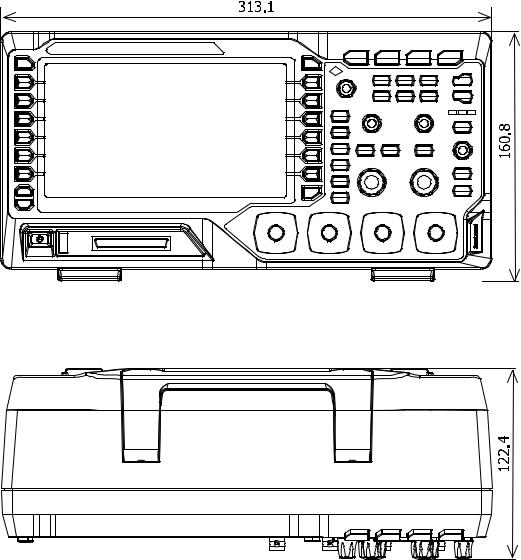
Chapter 1 Quick Start |
RIGOL |
Appearance and Dimensions
Figure 1-1 Front View |
Unit: mm |
Figure 1-2 Top View |
Unit: mm |
MSO1000Z/DS1000Z User’s Guide |
1-3 |
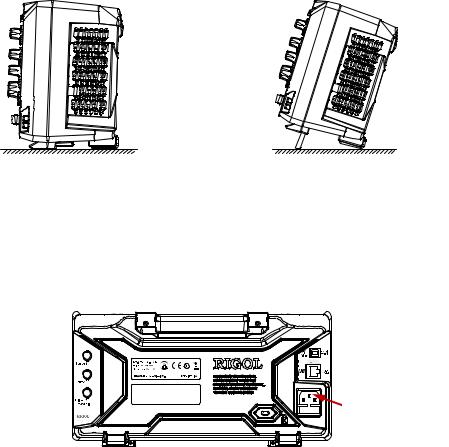
RIGOL |
Chapter 1 Quick Start |
To Prepare the Oscilloscope for Use
To Adjust the Supporting Legs
Adjust the supporting legs properly to use them as stands to tilt the oscilloscope upwards for stable placement of the oscilloscope as well as better operation and observation.
Figure 1-3 To Adjust the Supporting Legs
To Connect to Power Supply
The power requirements of the oscilloscope are 100-240 V, 45-440 Hz. Please use the power cord supplied with the accessories to connect the oscilloscope to the AC power source as shown in the figure below.
Power Socket
Figure 1-4 To Connect to Power Supply
1-4 |
MSO1000Z/DS1000Z User’s Guide |
